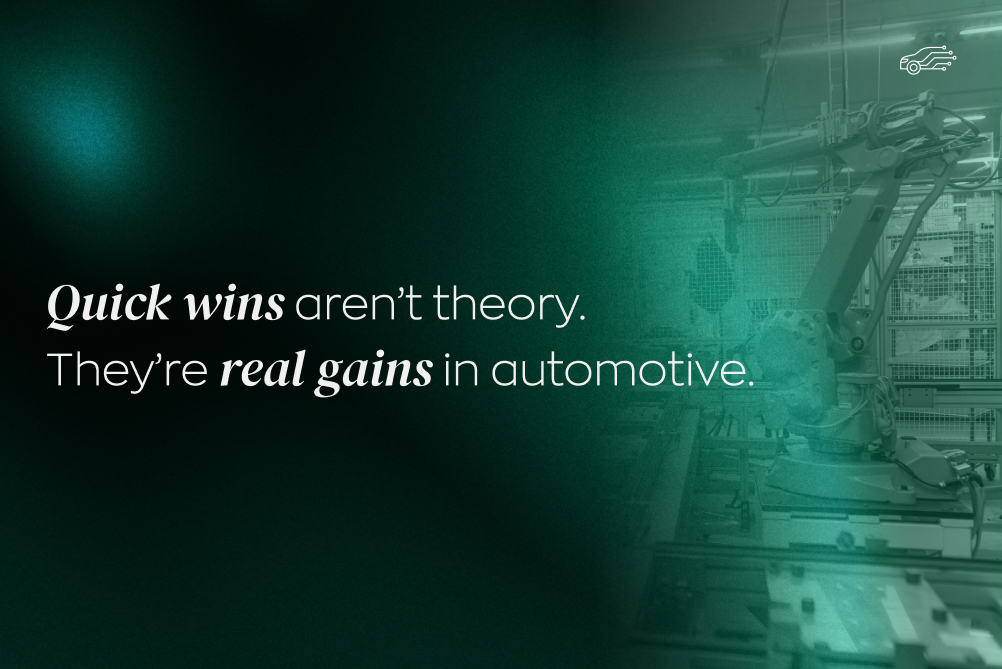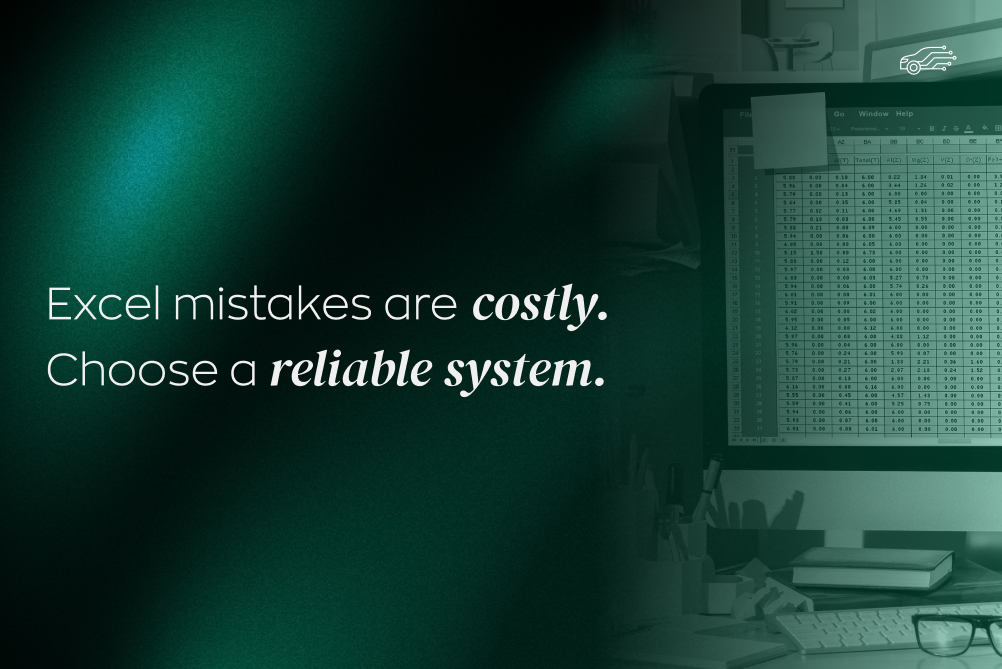Do you sometimes feel like your company is driving with the handbrake on? Despite great potential, a dedicated team, and high-quality products, something constantly slows growth, generates unnecessary costs, and causes frustration. If this feeling sounds familiar, you’re not alone. Many automotive companies struggle with an invisible enemy - outdated manual processes that silently drain both time and money. This problem is like a small leak in a fuel system - barely noticeable at first, but on a long journey it leads to massive losses.
The good news is that there are proven ways to patch that leak and shift into a higher gear on the road to efficiency.
Main reasons why manual processes still exist in automotive companies
Why, in the era of advanced technology, do so many businesses still rely on spreadsheets, paper documents, and manual data entry? The reasons are complex, but usually come down to a few key barriers:
- Fear of change: Resistance to new tools is natural. Employees used to old methods may worry they won’t be able to handle modern solutions.
- Perceived high costs: Investment in automation is often seen as an expense rather than a strategic move that pays off in the long run.
- Lack of knowledge and time: Managers caught up in day-to-day operations rarely have the time to research or implement new technologies.
- “It works well enough” mindset: If processes function - even inefficiently - there’s often little motivation to improve them. But this trap blocks growth in the long term.
Manual processes most often dominate in areas such as warehouse management, order processing, invoicing, reporting, and production planning. Each of these areas is a potential source of losses that accumulate day after day.
Financial and time-related consequences of manual processes
Driving with the handbrake on doesn’t just slow you down—it wastes fuel and damages the car. The same goes for manual processes. Their negative impact can be seen in many areas:
- Costly mistakes: Manual data entry easily leads to errors - an incorrect part number in an order, a mistake in an invoice, or inaccurate reporting. Each error means financial loss and time wasted fixing it.
- Slower production and order fulfillment: Information flow based on paper or emails is slow and chaotic. The result? Delays, downtime, and dissatisfied customers who might turn to competitors next time.
- Employee frustration and burnout: No one enjoys repetitive, monotonous tasks. Assigning skilled employees to manual data entry wastes their potential and decreases motivation.
- Lack of control and visibility: When data is scattered across files and binders, making accurate business decisions becomes nearly impossible. Instead of relying on insights, you’re left guessing.
Key automation technologies in the automotive industry
Fortunately, there’s an entire arsenal of tools to take your foot off the brake and step on the gas. Automation is no longer a luxury for giants - it’s becoming the standard for small and mid-sized companies too. Here are the most impactful technologies:
- ERP systems (Enterprise Resource Planning): The heart of an automated company. ERP integrates all core processes - orders, production, warehouse, finance, and accounting - into a single system, ensuring data consistency and full business visibility.
- MES systems (Manufacturing Execution Systems): Software for managing and monitoring production in real time. MES helps optimize machine use, track orders, and respond instantly to issues.
- Document automation (OCR): Tools that automatically read data from invoices, orders, or warehouse documents and enter it into systems. This eliminates manual retyping and reduces errors almost to zero.
- Robotics and industrial automation: Robots on production lines are already standard, but automation extends further - into warehouses (autonomous vehicles) and quality control (vision systems).
Case studies: Companies that successfully automated
Theory is one thing, but how does automation work in practice? Let’s look at two examples:
Case study 1: Spare parts manufacturer
- Problem: The company struggled with order mistakes, delivery delays, and warehouse chaos. Manual stock management caused shortages and overstocks.
- Solution: Implementation of an ERP system integrated with a Warehouse Management System (WMS).
- Results: Order processing time reduced by 40%, errors in picking cut by 95%, and inventory optimization saved hundreds of thousands annually.
Case study 2: Car service and tire distributor
- Problem: Employees wasted hours on manual invoicing, handling reservations via phone/email, and creating sales reports.
- Solution: Implementation of a service management system automating online booking, invoicing, and customer communication.
- Results: Two hours saved per day per service advisor, higher customer satisfaction thanks to SMS notifications, and a 15% sales increase due to improved data management.
Best practices and potential pitfalls in automation
The road to automation can have bumps along the way. To avoid pitfalls, keep these rules in mind:
How to do it right:
- Start with an audit: Identify which processes cause the most problems and costs before choosing tools.
- Involve your team: Get employees on board early and show them how automation will make their work easier, not take it away.
- Choose flexible solutions: Systems should adapt to your company—not the other way around. Look for scalable, customizable tools.
- Implement in stages: Don’t try to change everything at once. Begin with one key area, achieve success, and expand from there.
What to avoid:
- Ignoring employee resistance: A disengaged team can sabotage even the best system.
- Choosing the cheapest solution: The wrong system may create more problems than it solves.
- Skipping training: Even the best tool is useless if no one knows how to use it.
The impact of automation on employees and organizational culture
The biggest fear around automation is job loss. Will systems and robots replace people? The truth is, automation doesn’t eliminate employees - it transforms their roles. It frees them from repetitive tasks so they can focus on what humans do best: problem-solving, building client relationships, and strategic thinking.
Instead of retyping invoices, employees can analyze sales data. Instead of searching for parts in a warehouse, they can optimize logistics. Automation is an investment in workforce development and in building a culture based on efficiency and innovation rather than survival.
Sticking to manual processes in today’s automotive industry means consciously giving up profits and growth. It means letting competitors who embraced technology long ago leave you behind. Automation isn’t a luxury - it’s a necessity. It’s the key to higher efficiency, lower costs, and a stronger competitive edge.
Change is possible and more accessible than you think. Start with one small step. Which process in your company frustrates you the most? Where do mistakes happen most often? That’s where the biggest potential lies. Take the first step today - time to release the brake and accelerate toward the future.





.jpg)




.jpg)
.jpg)


.jpg)
.jpg)



.jpg)
.jpg)
.jpg)
.jpg)
.jpg)

.jpg)
.jpg)
.jpg)
.jpg)
.jpg)
.jpg)
.jpg)
.jpg)
.jpg)
.jpg)






.jpg)
.jpg)
.jpg)

.jpg)

.jpg)


.jpg)
.jpg)

.jpg)
.jpg)

.jpg)

.jpg)
.jpg)
.jpg)

.jpg)
.webp)

.webp)


.jpg)









.webp)


.webp)

























